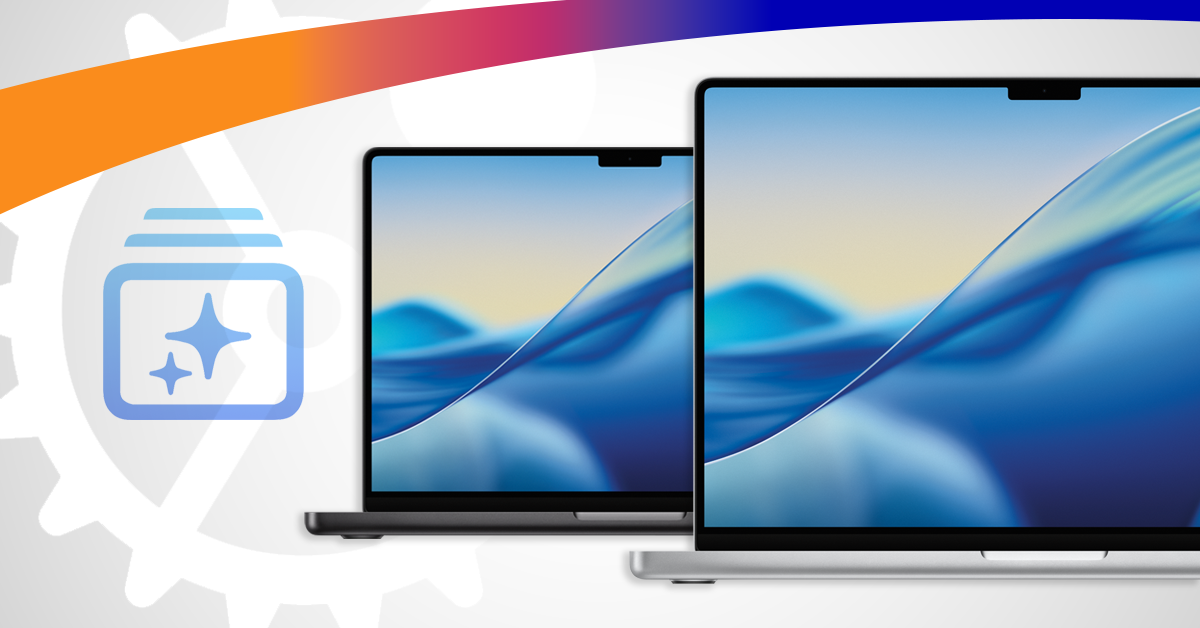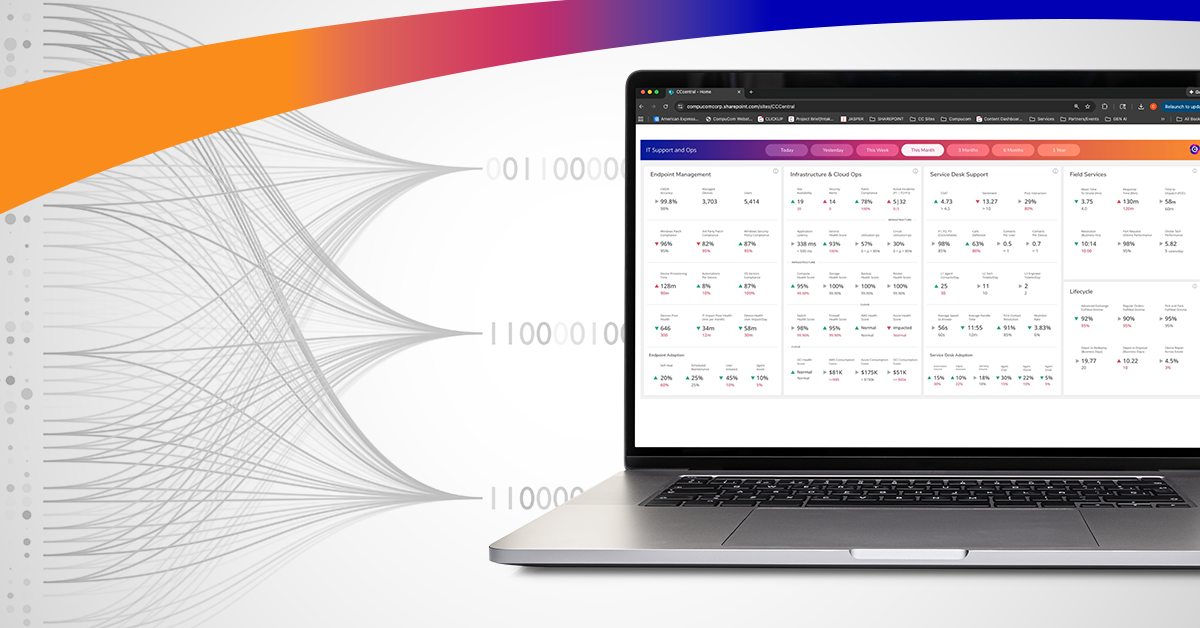- Managed Services and IT Support
- DEX

In today’s competitive hiring market, the right benefits go a long way in attracting top talent. But the business to employee experience is actually more integral to an organization’s overall success than just getting and keeping workers.
McKinsey defines the employee experience as “companies and their people working together to create personalized, authentic experiences that ignite passion and tap into purpose to strengthen individual, team, and company performance.”
What makes getting the right employee experience especially challenging now is there are so many generations in the workplace – with widely different ideas about how to work. The nature of work is also in the middle of a rapid metamorphosis. People demand more flexibility and want the ability to work remotely wherever and whenever.
As organizations work towards digital transformation goals, employee experience goes hand-in-hand with creating the agility and processes necessary to drive better business outcomes. In fact, Gartner listed employee experience as the third-highest key initiative in a survey of HR leaders.
Where IT Fits in the Employee Experience
The definition of employee experience is very broad. After all, it encompasses everything a person sees, hears, and touches in the workplace. It’s everything from relationships with co-workers to HR policies.
When you consider how much time in the modern workplace involves interactions with technology now, IT plays an enormous role in how individuals feel about their jobs.
Poor experiences or unmet expectations quickly have a chilling effect on the relationship between an employee and the organization – not to mention the potential for poor business outcomes.
The Three Employee Experience Factors IT Leaders Should Focus On
1. Win with Empathy
“Walk a mile in someone else’s shoes” is a well-worn cliché, but there’s a reason it’s overused: it’s true. For IT leaders, understanding the end user’s needs – what’s working and what’s not – is paramount to creating good user experiences.
Embrace Age Diversity
The first thing to recognize is that all end-user needs are not the same. Part of that is generational attitudes, and there are currently five generations in the workforce:
- Traditionalists – born before 1946
- Baby Boomers – born between 1946 and 1964
- Generation X – born between 1965 and 1980
- Generation Y, or Millennials – born between 1981 and 1997
- Generation Z – born after 1997
From an IT perspective, Baby Boomers are more comfortable with structure and may prefer a traditional office environment. Millennials grew up with more technology and often prefer flexible hours, remote work, and a higher level of collaboration.
Older workers now often have the option of choosing to cross-pollinate elements of retirement with elements of work. For example, many older workers have cut back hours to pursue personal causes or interests, but still, clock in between 15 to 30 hours of work a week.
Meanwhile, many of the younger generations are choosing to have a primary job and take on a secondary role online and off-hours to support a lifestyle or pursue a passion.
Treat Workers Like Customers
Decades ago, the tools you got in the workplace were often better than what you had at home, but that paradigm has shifted over the last 15 years. Workers often have better smartphones and laptops than work-issued equipment, and that leads to frustration when it doesn’t work as well.
The so-called “consumerization of IT” has led to trends like “Bring Your Own Device” policies, but it goes far beyond equipment. Workers want cloud data storage, social media access, and web-based email that’s easier to get to remotely.
Be Location Agnostic
Then, there are geographic considerations. Workers are getting priced out of expensive major metro areas, such as San Francisco, and are moving to more affordable areas while still expecting many of the same amenities. As a result, more companies now have to contend with a workforce that is spread throughout the United States.
2. Find the Right Tools
Armed with an empathetic understanding of what the end user needs, IT leaders need to find or design the right tools to meet those needs.
Solutions Must Be Seamless
Above all else, solutions must be simple to use and work smoothly from every needed location. Talking to the people doing day-to-day work is a fast way to figure out where the holes are, what legacy systems are holding you back, and why there are communication and collaboration breakdowns. Such discussions also promote employee buy-in when solutions are rolled out because they’ll have had input from the beginning and have likely taken part in some of the solution iteration and testing.
Leverage Data
Big data is revolutionizing digital customer experiences in the marketplace, and it’s useful in the workplace, too. Workforce analytics not only quantify things like productivity and performance but give useful real-time information about the overall employee experience as well.
Data helps the development of personas, which lets you align your technology with the needs of the business and employees to ensure the right people get the right applications, devices, and access at the right time.
How Can Artificial Intelligence Help?
Is it time to leverage artificial intelligence and automation to do some of the work? AI can automate repetitive tasks that lead to boredom and burnout for workers. Such technology can create hybrid employees who use bots for recurring labor while they focus on other things. The idea can be threatening at first for some people, but with the right training and understanding, they’ll quickly realize the value of such tools to their overall productivity.
3. Give Employees the Right Support
Once you have the right technology to drive the best experiences, it has to work seamlessly and reliably – every time. Nothing disrupts productivity and collaboration – or spoils attitudes – faster than continuous IT problems. The right support also improves onboarding and gets employees off on the right foot.
Provide a Concierge Experience
With the consumerism of IT, support also has to meet workers’ expectations anytime and anywhere. They’re looking for the same level of support that they’d get from a hotel concierge. If you think about it, a concierge is a person you go to and they give you a delightful helpful experience. They’ve got expertise, they know all the answers, and they help you in the way you want to be helped.
Offer Multi-Channel Support
The concierge experience means offering multi-channel support – whether an end user wants to pick up the phone and talk to a traditional Service Desk or they prefer to text or chat through a mobile app. Organizations with large campuses might also consider walk-up services where workers can drop in to get support as casually as they’d swing by the cafeteria vending machines.
Fix It Before They Know It’s Broken
Proactive technology like Self Healing – which uses AI and automation to find problems and fix them without the end user needing to pick up the phone or file a repair ticket – can also radically improve user experience. It’s great for common problems like network outages or offline printers and is a security-first line of defense against malware or intrusions.
Good Employee Experiences Are Essential to Compete
The new employee demands access to technology, data, and company resources around the clock from wherever they’re located. Yes, it’s a challenge, but there’s a tremendous upside too. Generational diversity means workers who attack problems from a wide variety of perspectives, and that leads to better ideas and solutions. Workers who’ve embraced technology in their private lives are far savvier and flexible than ones who have not. And, companies that can leverage a workforce that is spread out geographically enjoy a larger talent pool to pick from than ones who cannot.
With the consumerization of IT and digital transformation, today’s workers are very tech-savvy and quickly lose patience if their work tools aren’t at least as good as what they have in their private lives. If they have a sense of continuous roadblocks to their productivity and nimbleness on the job, their overall attitudes will suffer and the organization as a whole will suffer. In today’s highly competitive digital-first business climate, that’s not an option companies can afford.
RecenT

The Mac Management Playbook: 8 Steps to Deployment at Scale

Full Lifecycle, Full Visibility: Maximizing the Value of Mac in the Enterprise

Mac in the Enterprise — Myth vs. Reality: Debunking the Top Barriers to Adoption

Maturity Assessments Set a Clear Path to IT Modernization

Opportunity in Uncertainty: Leveraging Data for Fearless Decision-Making

Opportunity in Uncertainty: Turning 6 Top IT Challenges into Strategic Advantages
TOPICS
3 Employee Experience Factors IT Leaders Should Focus On
- Managed Services and IT Support
- DEX
In today’s competitive hiring market, the right benefits go a long way in attracting top talent. But the business to employee experience is actually more integral to an organization’s overall success than just getting and keeping workers.
McKinsey defines the employee experience as “companies and their people working together to create personalized, authentic experiences that ignite passion and tap into purpose to strengthen individual, team, and company performance.”
What makes getting the right employee experience especially challenging now is there are so many generations in the workplace – with widely different ideas about how to work. The nature of work is also in the middle of a rapid metamorphosis. People demand more flexibility and want the ability to work remotely wherever and whenever.
As organizations work towards digital transformation goals, employee experience goes hand-in-hand with creating the agility and processes necessary to drive better business outcomes. In fact, Gartner listed employee experience as the third-highest key initiative in a survey of HR leaders.
Where IT Fits in the Employee Experience
The definition of employee experience is very broad. After all, it encompasses everything a person sees, hears, and touches in the workplace. It’s everything from relationships with co-workers to HR policies.
When you consider how much time in the modern workplace involves interactions with technology now, IT plays an enormous role in how individuals feel about their jobs.
Poor experiences or unmet expectations quickly have a chilling effect on the relationship between an employee and the organization – not to mention the potential for poor business outcomes.
The Three Employee Experience Factors IT Leaders Should Focus On
1. Win with Empathy
“Walk a mile in someone else’s shoes” is a well-worn cliché, but there’s a reason it’s overused: it’s true. For IT leaders, understanding the end user’s needs – what’s working and what’s not – is paramount to creating good user experiences.
Embrace Age Diversity
The first thing to recognize is that all end-user needs are not the same. Part of that is generational attitudes, and there are currently five generations in the workforce:
- Traditionalists – born before 1946
- Baby Boomers – born between 1946 and 1964
- Generation X – born between 1965 and 1980
- Generation Y, or Millennials – born between 1981 and 1997
- Generation Z – born after 1997
From an IT perspective, Baby Boomers are more comfortable with structure and may prefer a traditional office environment. Millennials grew up with more technology and often prefer flexible hours, remote work, and a higher level of collaboration.
Older workers now often have the option of choosing to cross-pollinate elements of retirement with elements of work. For example, many older workers have cut back hours to pursue personal causes or interests, but still, clock in between 15 to 30 hours of work a week.
Meanwhile, many of the younger generations are choosing to have a primary job and take on a secondary role online and off-hours to support a lifestyle or pursue a passion.
Treat Workers Like Customers
Decades ago, the tools you got in the workplace were often better than what you had at home, but that paradigm has shifted over the last 15 years. Workers often have better smartphones and laptops than work-issued equipment, and that leads to frustration when it doesn’t work as well.
The so-called “consumerization of IT” has led to trends like “Bring Your Own Device” policies, but it goes far beyond equipment. Workers want cloud data storage, social media access, and web-based email that’s easier to get to remotely.
Be Location Agnostic
Then, there are geographic considerations. Workers are getting priced out of expensive major metro areas, such as San Francisco, and are moving to more affordable areas while still expecting many of the same amenities. As a result, more companies now have to contend with a workforce that is spread throughout the United States.
2. Find the Right Tools
Armed with an empathetic understanding of what the end user needs, IT leaders need to find or design the right tools to meet those needs.
Solutions Must Be Seamless
Above all else, solutions must be simple to use and work smoothly from every needed location. Talking to the people doing day-to-day work is a fast way to figure out where the holes are, what legacy systems are holding you back, and why there are communication and collaboration breakdowns. Such discussions also promote employee buy-in when solutions are rolled out because they’ll have had input from the beginning and have likely taken part in some of the solution iteration and testing.
Leverage Data
Big data is revolutionizing digital customer experiences in the marketplace, and it’s useful in the workplace, too. Workforce analytics not only quantify things like productivity and performance but give useful real-time information about the overall employee experience as well.
Data helps the development of personas, which lets you align your technology with the needs of the business and employees to ensure the right people get the right applications, devices, and access at the right time.
How Can Artificial Intelligence Help?
Is it time to leverage artificial intelligence and automation to do some of the work? AI can automate repetitive tasks that lead to boredom and burnout for workers. Such technology can create hybrid employees who use bots for recurring labor while they focus on other things. The idea can be threatening at first for some people, but with the right training and understanding, they’ll quickly realize the value of such tools to their overall productivity.
3. Give Employees the Right Support
Once you have the right technology to drive the best experiences, it has to work seamlessly and reliably – every time. Nothing disrupts productivity and collaboration – or spoils attitudes – faster than continuous IT problems. The right support also improves onboarding and gets employees off on the right foot.
Provide a Concierge Experience
With the consumerism of IT, support also has to meet workers’ expectations anytime and anywhere. They’re looking for the same level of support that they’d get from a hotel concierge. If you think about it, a concierge is a person you go to and they give you a delightful helpful experience. They’ve got expertise, they know all the answers, and they help you in the way you want to be helped.
Offer Multi-Channel Support
The concierge experience means offering multi-channel support – whether an end user wants to pick up the phone and talk to a traditional Service Desk or they prefer to text or chat through a mobile app. Organizations with large campuses might also consider walk-up services where workers can drop in to get support as casually as they’d swing by the cafeteria vending machines.
Fix It Before They Know It’s Broken
Proactive technology like Self Healing – which uses AI and automation to find problems and fix them without the end user needing to pick up the phone or file a repair ticket – can also radically improve user experience. It’s great for common problems like network outages or offline printers and is a security-first line of defense against malware or intrusions.
Good Employee Experiences Are Essential to Compete
The new employee demands access to technology, data, and company resources around the clock from wherever they’re located. Yes, it’s a challenge, but there’s a tremendous upside too. Generational diversity means workers who attack problems from a wide variety of perspectives, and that leads to better ideas and solutions. Workers who’ve embraced technology in their private lives are far savvier and flexible than ones who have not. And, companies that can leverage a workforce that is spread out geographically enjoy a larger talent pool to pick from than ones who cannot.
With the consumerization of IT and digital transformation, today’s workers are very tech-savvy and quickly lose patience if their work tools aren’t at least as good as what they have in their private lives. If they have a sense of continuous roadblocks to their productivity and nimbleness on the job, their overall attitudes will suffer and the organization as a whole will suffer. In today’s highly competitive digital-first business climate, that’s not an option companies can afford.
Recent Blogs

The Mac Management Playbook: 8 Steps to Deployment at Scale

Full Lifecycle, Full Visibility: Maximizing the Value of Mac in the Enterprise

Mac in the Enterprise — Myth vs. Reality: Debunking the Top Barriers to Adoption

Maturity Assessments Set a Clear Path to IT Modernization

Opportunity in Uncertainty: Leveraging Data for Fearless Decision-Making




